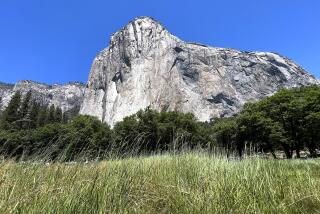Opinion: Make a reservation to visit Yosemite or Zion? It might become necessary

- Share via
Anybody who has visited Yosemite, Zion, or any of the other marquee national parks during peak tourism season knows what a frustrating experience it can be.
Over the past decade, visits to Yosemite grew from 3.2 million people a year to 4.3 million, and Zion went from 2.7 million to 4.3 million. In fact, the crush has gotten so bad at Zion that park administrators are considering a reservation system for park entry, or for specific park attractions.
As unappealing as that might be, it could be the best solution to a vexing problem that has been building for years.
Preserving the nature of the parks themselves should be the top priority.
The national parks system dates to 1872 with the designation of Yellowstone; the National Park Service began in 1916. There currently are 417 national park sites, only 59 of which have “National Park” as part of the title, but 72 of which receive at least 1 million visitors a year.
Some sites can handle the flow — such as the Lincoln Memorial on the National Mall in Washington, D.C. But parks such as Zion, Yosemite, Yellowstone and others with limited infrastructure run into problems with traffic, overnight accommodations, wear-and-tear on facilities, and the trampling of the natural beauty that draws visitors in the first place.
The parks system has for years faced underfunding problems, with $11.3 billion in deferred maintenance projects in a department with a $3.4-billion annual budget — which president Trump wants to slash to $2.6 billion (hopefully, the Republicans controlling Congress appreciate the value of national parks, and the damage such a deep cut would cause). And the problems have increased with the increased traffic within the parks.
How best to reduce the overcrowding is the question. There’s a free-market argument to be made that increasing the admission price would thin the crowds, but such a move would seem to undercut the basic premise of the parks system as preserving space in the name of the people and for the use of the people. Setting up a pricing mechanism that would unduly burden low-income families is inherently unfair. And if need-based free passes were issued, the pricing pan would be less effective at reducing demand.
A reservation system makes sense, but it may need to be done by lottery to truly be fair. Otherwise, those with the time to sit on a computer as the reservations window opens get the advantage, a frustration familiar to anyone who has tried to reserve a cottage at Crystal Cove State Park in Orange County, where reservations can be made for six months in advance, but rentals are gone within minutes of opening up.
Whichever method the National Parks Service settles on, reducing the load on the most-used and most-overrun of the parks is necessary. Preserving the nature of the parks themselves should be the top priority, followed by allowing the most access possible — but without undercutting what makes places like Yosemite and Zion so popular in the first place.
Follow my posts and re-tweets at @smartelle on Twitter
More to Read
A cure for the common opinion
Get thought-provoking perspectives with our weekly newsletter.
You may occasionally receive promotional content from the Los Angeles Times.










